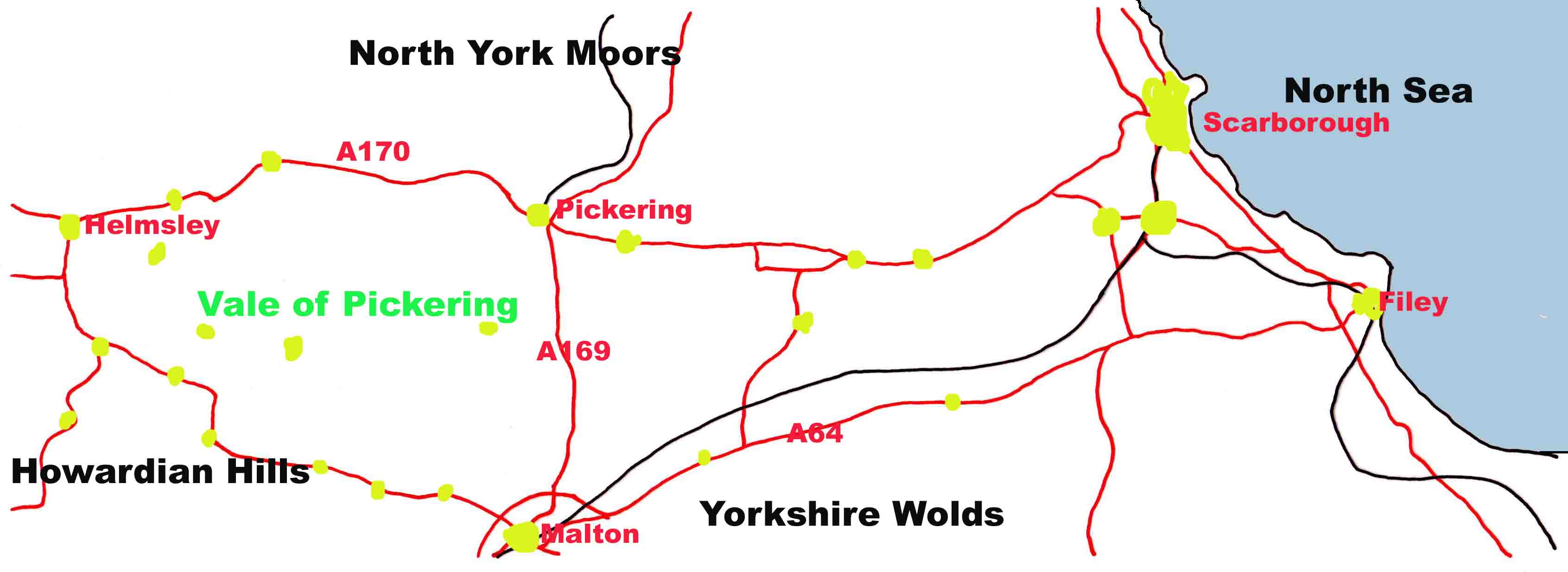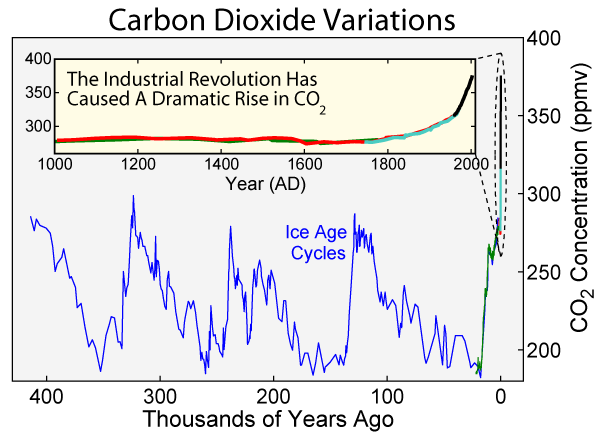|
Kirkdale Cave
Kirkdale Cave is a cave and fossil site located in Kirkdale near Kirkbymoorside in the Vale of Pickering, North Yorkshire, England. The cave was discovered by workmen in 1821, and was found to contain fossilized bones of a variety of mammals not currently found in Great Britain, including hippopotamus (the farthest north any such remains have ever been found), elephant, and the remains of numerous cave hyenas. William Buckland analyzed the cave and its contents in December 1821: he determined that the bones were from the remains of animals brought into the cave by hyenas who had been using it for a den, and not a result of the Biblical flood floating animal remains in from distant lands as he had first thought. His reconstruction of an ancient ecosystem from detailed analysis of fossil evidence was admired at the time, and considered to be an example of how geo-historical research should be done. The cave was extended from its original length of to by Scarborough Caving Club ... [...More Info...] [...Related Items...] OR: [Wikipedia] [Google] [Baidu] |
Vale Of Pickering
The Vale of Pickering is a low-lying flat area of land in North Yorkshire, England. It is drained by the River Derwent. The landscape is rural with scattered villages and small market towns. It has been inhabited continuously from the Mesolithic period. The present economy is largely agricultural with light industry and tourism playing an increasing role. Location and transport The Vale of Pickering is a low-lying plain, orientated in an east–west direction. It is well defined by the Yorkshire Wolds escarpment to the south, the Corallian limestone foothills of the North York Moors to the north, the North Sea coast to the east and the Howardian Hills to the west. The east–west-orientated main roads ( A64 and A170) in the vale follow the shoreline of the glacial lake, which formed in the vale after the last ice age. The main A169 road crosses the vale in a north–south direction, joining the market towns of Malton and Pickering. At the eastern edge of the vale the A165 ... [...More Info...] [...Related Items...] OR: [Wikipedia] [Google] [Baidu] |
Buckland Hyena
Buckland may refer to: People *Buckland (surname) Places Australia * Buckland, Queensland, a rural locality in the Central Highlands Region * Buckland, Tasmania, a rural locality * Buckland County, New South Wales * Buckland River (Victoria) * Buckland Military Training Area, Tasmania Canada *Rural Municipality of Buckland No. 491, Saskatchewan United Kingdom *Buckland, Buckinghamshire, a village and civil parish * Buckland, Devon, two places: a village and a suburb of Newton Abbot *Buckland, Gloucestershire, a village and civil parish *Buckland, New Forest, Hampshire *Buckland, Portsmouth, Hampshire, a residential area of the city of Portsmouth *Buckland, Hertfordshire, a village and civil parish *Buckland, Kent, a village *Buckland, Oxfordshire, a village and civil parish *Buckland, Surrey, a village and civil parish United States * Buckland, Alaska, a city * Buckland River, Alaska * Buckland, Massachusetts, a town * Buckland, Ohio, a village * Buckland, Virginia, an uninco ... [...More Info...] [...Related Items...] OR: [Wikipedia] [Google] [Baidu] |
Site Of Special Scientific Interest
A Site of Special Scientific Interest (SSSI) in Great Britain or an Area of Special Scientific Interest (ASSI) in the Isle of Man and Northern Ireland is a conservation designation denoting a protected area in the United Kingdom and Isle of Man. SSSI/ASSIs are the basic building block of site-based nature conservation legislation and most other legal nature/geological conservation designations in the United Kingdom are based upon them, including national nature reserves, Ramsar sites, Special Protection Areas, and Special Areas of Conservation. The acronym "SSSI" is often pronounced "triple-S I". Selection and conservation Sites notified for their biological interest are known as Biological SSSIs (or ASSIs), and those notified for geological or physiographic interest are Geological SSSIs (or ASSIs). Sites may be divided into management units, with some areas including units that are noted for both biological and geological interest. Biological Biological SSSI/A ... [...More Info...] [...Related Items...] OR: [Wikipedia] [Google] [Baidu] |
Humphry Davy
Sir Humphry Davy, 1st Baronet, (17 December 177829 May 1829) was a British chemist and inventor who invented the Davy lamp and a very early form of arc lamp. He is also remembered for isolating, by using electricity, several elements for the first time: potassium and sodium in 1807 and calcium, strontium, barium, magnesium and boron the following year, as well as for discovering the elemental nature of chlorine and iodine. Davy also studied the forces involved in these separations, inventing the new field of electrochemistry. Davy is also credited to have been the first to discover clathrate hydrates in his lab. In 1799 he experimented with nitrous oxide and was astonished at how it made him laugh, so he nicknamed it "laughing gas" and wrote about its potential anaesthetic properties in relieving pain during surgery. Davy was a baronet, President of the Royal Society (PRS), Member of the Royal Irish Academy (MRIA), Fellow of the Geological Society (FGS), and a mem ... [...More Info...] [...Related Items...] OR: [Wikipedia] [Google] [Baidu] |
Copley Medal
The Copley Medal is an award given by the Royal Society, for "outstanding achievements in research in any branch of science". It alternates between the physical sciences or mathematics and the biological sciences. Given every year, the medal is the oldest Royal Society medal awarded and the oldest surviving scientific award in the world, having first been given in 1731 to Stephen Gray, for "his new Electrical Experiments: – as an encouragement to him for the readiness he has always shown in obliging the Society with his discoveries and improvements in this part of Natural Knowledge". __TOC__ History The medal was created following a donation of £100 to be used for carrying out experiments by Sir Godfrey Copley, for which the interest on the amount was used for several years. The conditions for the medal have been changed several times; in 1736, it was suggested that "a medal or other honorary prize should be bestowed on the person whose experiment should be best approved ... [...More Info...] [...Related Items...] OR: [Wikipedia] [Google] [Baidu] |
Yorkshire Philosophical Society
The Yorkshire Philosophical Society (YPS) is a charitable learned society (charity reg. 529709) which aims to promote the public understanding of the natural sciences, the social sciences, and the archaeology and history of York and Yorkshire. History The Society was formed in York in December 1822 by James Atkinson, William Salmond, Anthony Thorpe and William Vernon. The Society's aim was to gain and spread knowledge related to science and history and they built a large collection for this purpose. The geologist John Phillips was employed as the Society's first keeper of its museum. In 1828 the Society was given, by royal grant, some of the grounds of St Mary's Abbey including the ruins of the abbey. On this land the Society constructed a number of buildings including the Yorkshire Museum built to house the Society's geological and archaeological collections and opened in 1830. Landscape architect Sir John Murray Naysmith was commissioned by the Society to create a botani ... [...More Info...] [...Related Items...] OR: [Wikipedia] [Google] [Baidu] |
Yorkshire Museum
The Yorkshire Museum is a museum in York, England. It was opened in 1830, and has five permanent collections, covering biology, geology, archaeology, numismatics and astronomy. History The museum was founded by the Yorkshire Philosophical Society (YPS) to accommodate their geological and archaeological collections, and was originally housed in Ousegate, York, until the site became too small. In 1828, the society received by royal grant, of land formerly belonging to St Mary's Abbey for the purposes of building a new museum. The main building of the museum is called the Yorkshire Museum; it was designed by William Wilkins in a Greek Revival style and is a Grade I listed building. It was officially opened in February 1830, which makes it one of the longest established museums in England. A condition of the royal grant was that the land surrounding the museum building should be a botanic gardens and one was created in the 1830s. The botanic gardens are now known as the Museum G ... [...More Info...] [...Related Items...] OR: [Wikipedia] [Google] [Baidu] |
Kirkdale Cave Hyena Mandible YORYM G1201 , Sydenham, London, England
{{disambiguation, geo ...
Kirkdale is the name of several places in the United Kingdom: *Kirkdale, Liverpool, an area of Liverpool, England **Liverpool Kirkdale (UK Parliament constituency) **Kirkdale railway station ** Kirkdale TMD, a traction maintenance depot **Kirkdale (ward) *Kirkdale, North Yorkshire, England *Kirkdale Estate, Galloway, Scotland; featured in the book '' The Thirty-Nine Steps'' by John Buchan *Kirkdale School Kirkdale School (1964 - 1980s) was a small, independent free school located at 186 Kirkdale, Sydenham, London, England. During the entirety of the school's existence it was run as a parent/teacher co-operative. Kirkdale is one of several free s ... [...More Info...] [...Related Items...] OR: [Wikipedia] [Google] [Baidu] |
Eemian
The Eemian (also called the last interglacial, Sangamonian Stage, Ipswichian, Mikulin, Kaydaky, penultimate,NOAA - Penultimate Interglacial Period http://www.ncdc.noaa.gov/global-warming/penultimate-interglacial-period Valdivia or Riss-Würm) was the interglacial period which began about 130,000 years ago at the end of the Penultimate Glacial Period and ended about 115,000 years ago at the beginning of the Last Glacial Period. It corresponds to Marine Isotope Stage 5e. Although sometimes referred to as the "last interglacial" (in the "most recent previous" sense of "last"), it was the second-to-latest interglacial period of the current Ice Age, the most recent being the Holocene which extends to the present day (having followed the last glacial period). The prevailing Eemian climate was, on average, around 1 to 2 degrees Celsius (1.8 to 3.6 Fahrenheit) warmer than that of the Holocene. During the Eemian, the proportion of in the atmosphere was about 280 parts per million. The ... [...More Info...] [...Related Items...] OR: [Wikipedia] [Google] [Baidu] |
Deluge (mythology)
A flood myth or a deluge myth is a myth in which a great flood, usually sent by a deity or deities, destroys civilization, often in an act of divine retribution. Parallels are often drawn between the flood waters of these myths and the primaeval waters which appear in certain creation myths, as the flood waters are described as a measure for the cleansing of humanity, in preparation for rebirth. Most flood myths also contain a culture hero, who "represents the human craving for life". The flood-myth motif occurs in many cultures, including the Mesopotamian flood stories, Native American in North America, the Genesis flood narrative, '' manvantara-sandhya'' in Hinduism, and Deucalion and Pyrrha in Greek mythology. Mythologies One example of a flood myth is the ''Epic of Gilgamesh''. Many scholars believe that this account was copied from the Akkadian ''Atra-Hasis'', which dates to the 18th century BCE. In the Gilgamesh flood myth, the highest god, Enlil, decides to d ... [...More Info...] [...Related Items...] OR: [Wikipedia] [Google] [Baidu] |
Geological Society Of London
The Geological Society of London, known commonly as the Geological Society, is a learned society based in the United Kingdom. It is the oldest national geological society in the world and the largest in Europe with more than 12,000 Fellows. Fellows are entitled to the postnominal FGS (Fellow of the Geological Society), over 2,000 of whom are Chartered Geologists (CGeol). The Society is a Registered Charity, No. 210161. It is also a member of the Science Council, and is licensed to award Chartered Scientist to qualifying members. The mission of the society is: "Making geologists acquainted with each other, stimulating their zeal, inducing them to adopt one nomenclature, facilitating the communication of new facts and ascertaining what is known in their science and what remains to be discovered". History The Society was founded on 13 November 1807 at the Freemasons' Tavern, Great Queen Street, in the Covent Garden district of London. It was partly the outcome of a previous ... [...More Info...] [...Related Items...] OR: [Wikipedia] [Google] [Baidu] |








